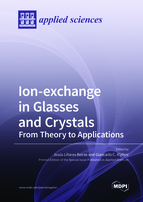Ion-exchange in Glasses and Crystals: from Theory to Applications
A special issue of Applied Sciences (ISSN 2076-3417). This special issue belongs to the section "Optics and Lasers".
Deadline for manuscript submissions: closed (25 April 2021) | Viewed by 24990
Special Issue Editors
Interests: quantum optics; integrated quantum photonics; fiber-optic and free-space quantum cryptography; interferometric optical spatial multiplexing
Special Issues, Collections and Topics in MDPI journals
Interests: glassy and glass-ceramic materials; nanostructured materials; microfabrication; integrated optics; optical microresonators
Special Issues, Collections and Topics in MDPI journals
Special Issue Information
Dear Colleagues,
We cordially invite you to contribute to this Special Issue on ion exchange in glasses and crystals. As you know, the ion-exchange reaction may be defined, according to Britannica.com, as any of a class of chemical reactions between two substances (each consisting of positively and negatively charged species called ions) that involves an exchange of one or more ionic components. Since its first observation in 1850, ion-exchange has become a fundamental process in many applications involving treatment and purification of water and, more generally, in catalysis, chromatography, food industry, pharmaceutical industry. One of the first relevant applications of ion-exchange, however, was in the industry of glass, with the surface tempering of glass produced by a K+-Na+ ion exchange; nowadays, ion exchange-strengthened glass is present in many smartphones. One century ago, in 1918, Schott researchers observed that ion exchange also produced an increase of the refractive index in the diffused layers.
In a century, the applications of the ion-exchange (IOX) process in glasses and crystals have been very many, allowing us the production of graded-index optical components and waveguides, of passive and active devices. Ion-exchange in glass and ferroelectric crystals, such as lithium niobate, has been fundamental for the development of many linear and nonlinear integrated optical devices.
This Special Issue aims at producing an updated overview of this wide field, reviewing the current state-of-the-art and presenting perspectives of further development. Contributions are sought related to fundamental aspects, design and fabrication processes, characterization, and, eventually, applications of ion-exchange technology in different types of glasses and crystals. Even if the core of this Special Issue will presumably be concerned with photonic applications, other uses of ion-exchange in glasses and crystals will also be of interest.
Original research papers in all areas of theory, fabrication, characterization and applications of ion-exchange in glasses, glass-ceramics, and crystals will be considered, including but not limited to:
- Thermal and field-assisted diffusion processes
- Ion-exchange processes in oxide glasses, chalcogenide glasses, other glasses
- Ion-exchange in glass-ceramics
- Ion-exchange processes in ferroelectric and other crystals
- Ion exchange in semiconductors
- Nanomaterials synthesis by ion-exchange techniques
- Modeling of ion-exchange process
- Graded-index structures by ion-exchange (microlenses, optical gratings, GRIN lenses, mode converters, etc.)
- Ion-exchange based integrated optics (waveguides, components, modulators, nonlinear devices, amplifiers and lasers, sensors, etc.)
- Other applications
Review articles on any aspect of ion-exchange in glasses and crystals will be considered as well. Prospective authors are encouraged to contact the Guest Editors to submit their proposal.
Prof. Dr. Jesús Liñares Beiras
Dr. Giancarlo C. Righini
Guest Editors
Manuscript Submission Information
Manuscripts should be submitted online at www.mdpi.com by registering and logging in to this website. Once you are registered, click here to go to the submission form. Manuscripts can be submitted until the deadline. All submissions that pass pre-check are peer-reviewed. Accepted papers will be published continuously in the journal (as soon as accepted) and will be listed together on the special issue website. Research articles, review articles as well as short communications are invited. For planned papers, a title and short abstract (about 100 words) can be sent to the Editorial Office for announcement on this website.
Submitted manuscripts should not have been published previously, nor be under consideration for publication elsewhere (except conference proceedings papers). All manuscripts are thoroughly refereed through a single-blind peer-review process. A guide for authors and other relevant information for submission of manuscripts is available on the Instructions for Authors page. Applied Sciences is an international peer-reviewed open access semimonthly journal published by MDPI.
Please visit the Instructions for Authors page before submitting a manuscript. The Article Processing Charge (APC) for publication in this open access journal is 2400 CHF (Swiss Francs). Submitted papers should be well formatted and use good English. Authors may use MDPI's English editing service prior to publication or during author revisions.
Keywords
- ion exchange
- diffusion
- graded-index structures
- optical materials
- fiber optics
- integrated optics
- diffractive optics
- microoptics
- nonlinear optics







